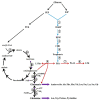Sensing, Uptake and Catabolism of L-Phenylalanine During 2-Phenylethanol Biosynthesis via the Ehrlich Pathway in Saccharomyces cerevisiae
- PMID: 33717002
- PMCID: PMC7947893
- DOI: 10.3389/fmicb.2021.601963
Sensing, Uptake and Catabolism of L-Phenylalanine During 2-Phenylethanol Biosynthesis via the Ehrlich Pathway in Saccharomyces cerevisiae
Abstract
2-Phenylethanol (2-PE) is an important flavouring ingredient with a persistent rose-like odour, and it has been widely utilized in food, perfume, beverages, and medicine. Due to the potential existence of toxic byproducts in 2-PE resulting from chemical synthesis, the demand for "natural" 2-PE through biotransformation is increasing. L-Phenylalanine (L-Phe) is used as the precursor for the biosynthesis of 2-PE through the Ehrlich pathway by Saccharomyces cerevisiae. The regulation of L-Phe metabolism in S. cerevisiae is complicated and elaborate. We reviewed current progress on the signal transduction pathways of L-Phe sensing, uptake of extracellular L-Phe and 2-PE synthesis from L-Phe through the Ehrlich pathway. Moreover, the anticipated bottlenecks and future research directions for S. cerevisiae biosynthesis of 2-PE are discussed.
Keywords: 2-phenylethanol; Ehrlich pathway; Saccharomyces cerevisiae; sensing of L-phenylalanine; uptake of L-phenylalanine.
Copyright © 2021 Dai, Xia, Yang and Chen.
Conflict of interest statement
The authors declare that this study received funding from China Tobacco Corporation and Hubei tobacco company. The funder was not involved in the study design, collection, analysis, interpretation of data, the writing of this article or the decision to submit it for publication.
Figures




Similar articles
-
Rapamycin enhanced the production of 2-phenylethanol during whole-cell bioconversion by yeast.Appl Microbiol Biotechnol. 2022 Oct;106(19-20):6471-6481. doi: 10.1007/s00253-022-12169-6. Epub 2022 Sep 13. Appl Microbiol Biotechnol. 2022. PMID: 36098787
-
Regulation of crucial enzymes and transcription factors on 2-phenylethanol biosynthesis via Ehrlich pathway in Saccharomyces cerevisiae.J Ind Microbiol Biotechnol. 2017 Jan;44(1):129-139. doi: 10.1007/s10295-016-1852-5. Epub 2016 Oct 21. J Ind Microbiol Biotechnol. 2017. PMID: 27770224
-
Utilization of a styrene-derived pathway for 2-phenylethanol production in budding yeast.Appl Microbiol Biotechnol. 2021 Mar;105(6):2333-2340. doi: 10.1007/s00253-021-11186-1. Epub 2021 Mar 2. Appl Microbiol Biotechnol. 2021. PMID: 33649922
-
Recent advances in biotechnological production of 2-phenylethanol.Biotechnol Adv. 2011 Nov-Dec;29(6):654-60. doi: 10.1016/j.biotechadv.2011.05.001. Epub 2011 May 13. Biotechnol Adv. 2011. PMID: 21601630 Review.
-
[Advances in biosynthesis of 2-phenylethanol by yeasts].Sheng Wu Gong Cheng Xue Bao. 2016 Sep 25;32(9):1151-1163. doi: 10.13345/j.cjb.150539. Sheng Wu Gong Cheng Xue Bao. 2016. PMID: 29022316 Review. Chinese.
Cited by
-
Aminotransferase SsAro8 Regulates Tryptophan Metabolism Essential for Filamentous Growth of Sugarcane Smut Fungus Sporisorium scitamineum.Microbiol Spectr. 2022 Aug 31;10(4):e0057022. doi: 10.1128/spectrum.00570-22. Epub 2022 Jul 6. Microbiol Spectr. 2022. PMID: 35862944 Free PMC article.
-
Identification of transporters involved in aromatic compounds tolerance through screening of transporter deletion libraries.Microb Biotechnol. 2024 Apr;17(4):e14460. doi: 10.1111/1751-7915.14460. Microb Biotechnol. 2024. PMID: 38635191 Free PMC article.
-
Exploring the biotechnological potential of Acinetobacter soli ANG344B: A novel bacterium for 2-phenylethanol production.Biotechnol Rep (Amst). 2024 Apr 4;42:e00839. doi: 10.1016/j.btre.2024.e00839. eCollection 2024 Jun. Biotechnol Rep (Amst). 2024. PMID: 38633817 Free PMC article.
-
The flavour of grape colour: anthocyanin content tunes aroma precursor composition by altering the berry microenvironment.J Exp Bot. 2023 Oct 31;74(20):6369-6390. doi: 10.1093/jxb/erad223. J Exp Bot. 2023. PMID: 37294268 Free PMC article.
-
Combining metabolite doping and metabolic engineering to improve 2-phenylethanol production by engineered cyanobacteria.Front Bioeng Biotechnol. 2022 Sep 20;10:1005960. doi: 10.3389/fbioe.2022.1005960. eCollection 2022. Front Bioeng Biotechnol. 2022. PMID: 36204466 Free PMC article.
References
-
- Abdel-Sater F., Iraqui I., Urrestarazu A., André B. (2004). The external amino acid signaling pathway promotes activation of Stp1 and Uga35/Dal81 transcription factors for induction of the AGP1 gene in Saccharomyces cerevisiae. Genetics 166, 1727–1739. 10.1534/genetics.166.4.1727, PMID: - DOI - PMC - PubMed
Publication types
LinkOut - more resources
Full Text Sources
Other Literature Sources
Molecular Biology Databases

